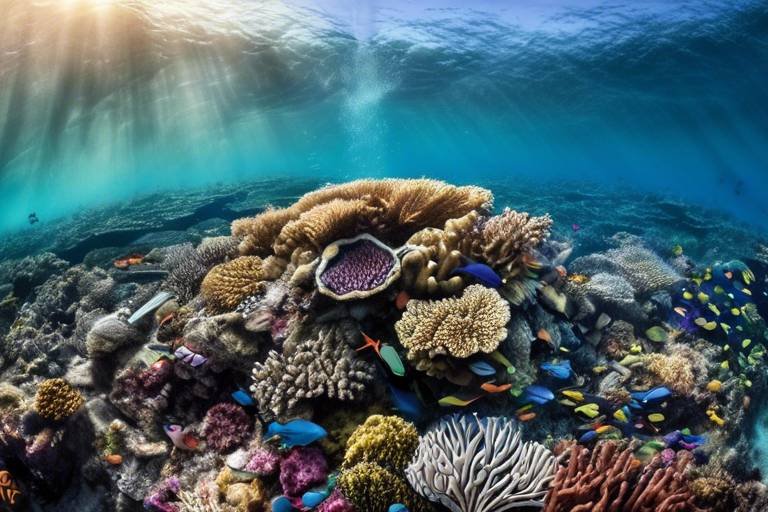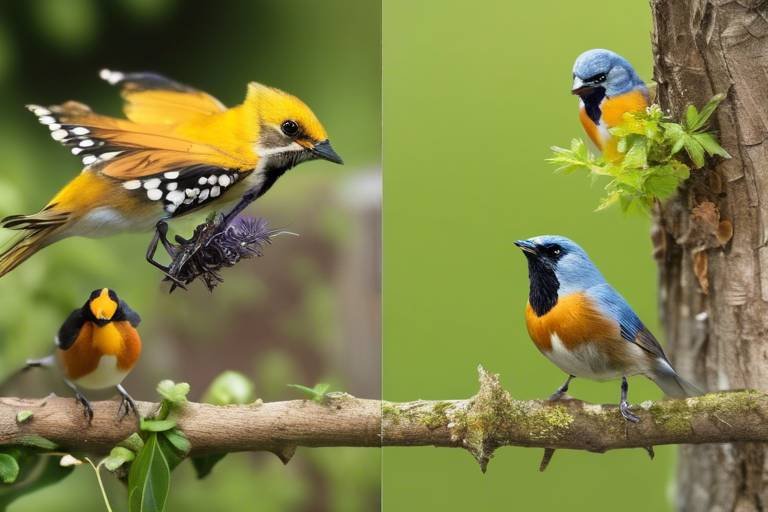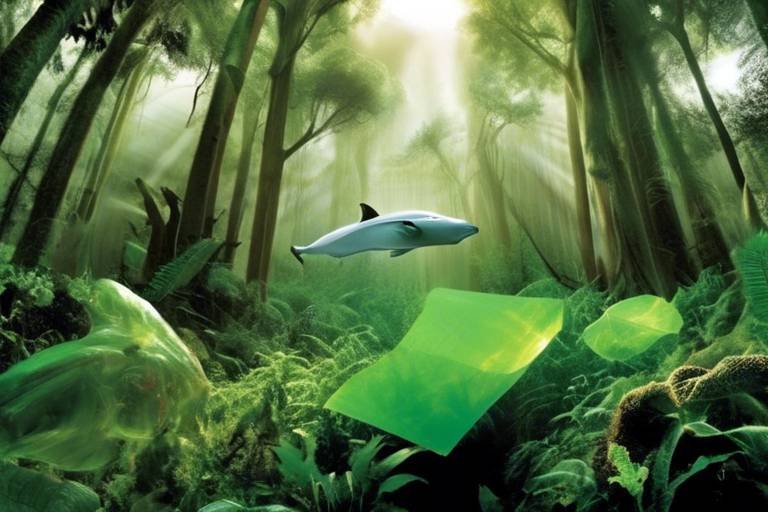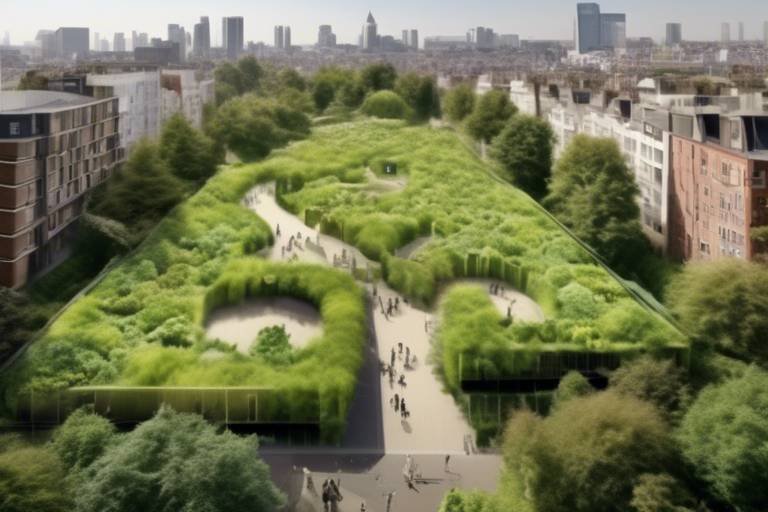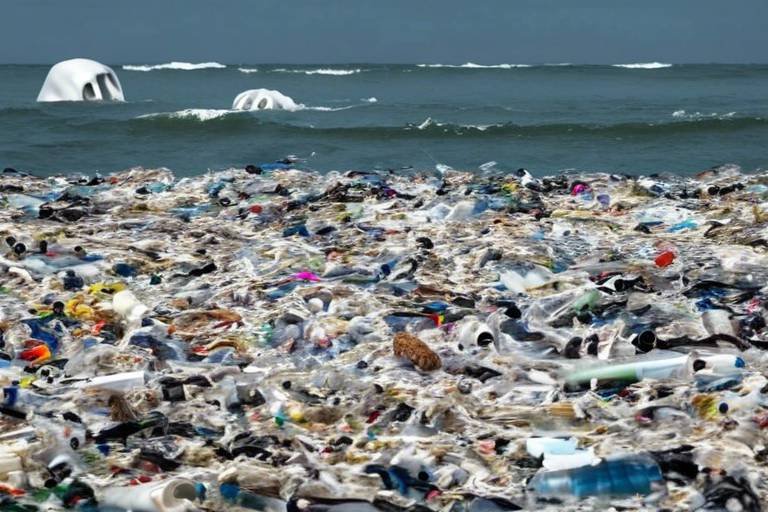Clash of Titans - Biodiversity versus Infrastructure
The struggle between biodiversity preservation and infrastructure development is akin to a fierce battle between two titans, each with its own set of champions and challenges. On one side, we have biodiversity, the intricate web of life that sustains ecosystems, provides food, and supports our health and well-being. On the other side, infrastructure development represents progress, urbanization, and the promise of economic growth. But what happens when these two forces collide? The implications are profound, not just for the environment, but also for our economies and future sustainability efforts.
As we delve deeper into this conflict, we uncover a complex landscape where every decision made in the name of development can have cascading effects on the natural world. Imagine a thriving forest, teeming with life, suddenly transformed into a concrete jungle. The delicate balance that has been maintained for centuries is disrupted, leading to habitat loss, species extinction, and a decline in ecosystem services. This isn't just a story about trees being cut down; it's about the very fabric of life being unraveled, and the consequences can be dire.
In this article, we will explore the importance of biodiversity, the trends in infrastructure development, and the challenges that arise when these two worlds intersect. We'll look at urbanization and its effects, examine case studies of urban expansion, and discuss innovative green infrastructure solutions that can help bridge the gap. Furthermore, we will navigate the complex policy and regulation challenges that must be addressed to find a balance between these competing interests.
As we journey through this clash of titans, we will also highlight the critical role of community involvement and awareness in shaping a sustainable future. After all, it's the local communities that often bear the brunt of development projects, and their voices are essential in advocating for biodiversity conservation. Through education and outreach programs, we can empower individuals to take action and influence infrastructure planning positively.
Ultimately, the clash between biodiversity and infrastructure is not just a battle; it’s a call to action. By understanding the implications of our choices and fostering collaboration among stakeholders, we can develop integrated solutions that honor both our need for progress and our responsibility to protect the planet. Together, we can navigate this complex terrain and work towards a future where biodiversity thrives alongside sustainable infrastructure.
- What is biodiversity and why is it important?
Biodiversity refers to the variety of life on Earth, including the diversity of species, ecosystems, and genetic variations. It is crucial for ecosystem stability, food security, and overall human health. - How does infrastructure development affect biodiversity?
Infrastructure development often leads to habitat destruction, fragmentation, and pollution, which can threaten local species and disrupt ecosystems. - What are green infrastructure solutions?
Green infrastructure solutions include practices like green roofs, permeable pavements, and urban forests that help manage stormwater, reduce heat, and support biodiversity in urban areas. - How can communities get involved in biodiversity conservation?
Communities can participate in education programs, advocacy efforts, and local conservation initiatives to raise awareness and influence infrastructure planning. - What role do policies play in balancing biodiversity and infrastructure?
Policies and regulations are essential for guiding development in a way that minimizes environmental impact and promotes sustainable practices.

The Importance of Biodiversity
Biodiversity is the intricate tapestry of life on Earth, encompassing the variety of species, ecosystems, and genetic diversity that make our planet vibrant and resilient. Imagine a world where every species plays a role, much like the instruments in an orchestra, each contributing to a harmonious symphony of life. This delicate balance is essential for the stability of ecosystems, which in turn supports our very existence. Without biodiversity, we risk unraveling the fabric of life that sustains us.
One of the most critical roles that biodiversity plays is in food security. Diverse ecosystems provide a wide range of crops, livestock, and aquatic species, ensuring that we have access to nutritious food. When we lose biodiversity, we also lose the variety of foods available to us, which can lead to malnutrition and food scarcity. For instance, consider the reliance on a few staple crops like rice and wheat; if a disease were to strike these crops, the consequences could be catastrophic. Hence, preserving biodiversity is not just an environmental issue—it's a matter of survival.
Moreover, biodiversity is closely linked to our health and well-being. Natural ecosystems offer numerous medicinal resources, with many pharmaceutical drugs derived from plant and animal compounds. The loss of species could mean losing potential cures for diseases. In fact, approximately 50% of modern medicines are derived from natural sources, highlighting the importance of conserving our biological heritage. Imagine walking through a rainforest, where each plant could hold the key to a new treatment; that’s the potential we stand to lose.
Economically, biodiversity contributes significantly to various industries, such as agriculture, fisheries, and tourism. Healthy ecosystems provide ecosystem services that are valued in trillions of dollars globally. For example, pollinators like bees are vital for the production of fruits and vegetables, yet their populations are declining. As a result, farmers may face reduced yields, leading to increased food prices and economic instability. The interdependence of biodiversity and economic well-being is a reality we cannot ignore.
Furthermore, biodiversity enhances ecosystem resilience, allowing natural systems to recover from disturbances such as natural disasters or climate change. Just as a diverse community can adapt to challenges more effectively than a homogenous one, ecosystems with a wide variety of species can better withstand environmental changes. This resilience is crucial for maintaining the services that ecosystems provide, such as clean water, air purification, and climate regulation.
In conclusion, the importance of biodiversity cannot be overstated. It is the foundation upon which our ecosystems, economies, and health are built. As we forge ahead with infrastructure development, it is essential to remember that the preservation of biodiversity is not just an environmental concern; it is a critical component of our survival and prosperity. We must strive to find a balance that allows for both growth and conservation, ensuring that future generations inherit a world rich in life and opportunity.

Infrastructure Development Trends
Infrastructure development is not just about building roads and bridges; it's about shaping the very fabric of our urban landscapes. As cities grow and populations swell, the demand for robust infrastructure becomes increasingly critical. However, this growth often comes at a significant cost to our natural environments. It's a classic case of growth versus preservation, and finding the right balance is more important than ever.
In recent years, we've seen a surge in infrastructure projects aimed at enhancing connectivity and boosting economic activity. Governments worldwide are investing in massive initiatives, such as high-speed rail systems, smart cities, and renewable energy installations. But here's the kicker: while these projects promise economic benefits, they can also lead to severe ecological repercussions. For instance, the construction of a new highway might provide faster travel times, but it can also fragment habitats and threaten local wildlife.
To illustrate this point, let's take a look at some current trends in infrastructure development:
- Smart City Initiatives: Cities are increasingly adopting technology to improve efficiency and sustainability. Smart traffic systems and energy-efficient buildings are becoming the norm, but they must be implemented with an eye toward preserving green spaces.
- Renewable Energy Projects: Wind farms and solar installations are sprouting up everywhere. While they reduce our carbon footprint, the land used for these projects often disrupts local ecosystems.
- Transportation Networks: Expanding public transport is essential for reducing congestion and pollution, but it often requires extensive construction that can encroach on natural habitats.
As we delve deeper into these trends, it becomes clear that the challenge lies in integrating ecological considerations into the planning phases of infrastructure projects. The construction industry has historically operated with a "build first, ask questions later" mentality. However, this approach is increasingly being challenged by environmental advocates who argue that we must consider the long-term impacts on biodiversity before breaking ground.
One promising approach is the concept of green infrastructure, which emphasizes the importance of incorporating natural elements into urban planning. This can include everything from creating green roofs and urban forests to implementing permeable pavements that allow rainwater to seep into the ground, reducing runoff and restoring natural hydrology. By utilizing these methods, cities can mitigate the adverse effects of urbanization while still accommodating growth.
Moreover, the rise of sustainable development goals (SDGs) has prompted a shift in how infrastructure projects are evaluated. Stakeholders are now considering not just the economic returns but also the social and environmental impacts. This holistic approach is crucial for ensuring that infrastructure development does not come at the expense of our planet's biodiversity.
In conclusion, while infrastructure development is essential for our modern lifestyles, it's vital that we navigate this landscape with caution. By understanding the implications of our choices and prioritizing sustainability, we can create urban environments that are not only functional but also harmonious with nature.

Urbanization and Its Effects
Urbanization is like a double-edged sword; on one side, it brings economic growth and improved living standards, while on the other, it often leads to significant environmental degradation. As cities expand to accommodate growing populations, the natural habitats that once thrived in these areas face unprecedented threats. The transformation of lush landscapes into concrete jungles disrupts ecosystems, leading to habitat destruction and fragmentation. This not only threatens the species that call these areas home but also compromises the vital services that biodiversity provides, such as clean air, water purification, and pollination.
Imagine a vibrant forest teeming with life, suddenly replaced by towering skyscrapers and bustling roads. The delicate balance of nature is thrown into disarray, and the consequences can be dire. Urbanization often results in the following effects on biodiversity:
- Habitat Loss: As land is cleared for new developments, countless species lose their homes, leading to a decline in local populations.
- Fragmentation: Even when habitats remain, they can become isolated from one another, making it difficult for species to migrate, find mates, or access resources.
- Pollution: Increased urban activity brings pollution in various forms—air, water, and noise—that can be detrimental to both human and wildlife health.
- Invasive Species: Urban areas can become hotspots for non-native species, which often outcompete local flora and fauna, further destabilizing ecosystems.
One of the most pressing concerns is the impact of urbanization on local wildlife. Many species are forced to adapt to urban environments or face extinction. For instance, birds that once nested in trees may find their habitats replaced by buildings, leading to decreased breeding success. Similarly, amphibians and reptiles, which rely on specific habitats, are particularly vulnerable to changes in land use.
However, understanding these effects is crucial for developing strategies to mitigate the negative impacts of urbanization. By integrating biodiversity considerations into urban planning, we can create cities that not only thrive economically but also support a rich tapestry of life. This requires innovative approaches such as green corridors, which connect fragmented habitats, and the implementation of policies that prioritize ecological health alongside urban development.
In conclusion, while urbanization is an inevitable part of modern life, it does not have to come at the expense of our planet’s biodiversity. By recognizing the profound effects urban expansion can have on natural ecosystems, we can begin to forge a path towards sustainable urban development that respects and nurtures the delicate balance of life.
- What is urbanization? Urbanization refers to the increasing population shift from rural to urban areas, resulting in the growth of cities.
- How does urbanization affect biodiversity? Urbanization leads to habitat loss, fragmentation, pollution, and the introduction of invasive species, all of which threaten local biodiversity.
- What can be done to mitigate the effects of urbanization on biodiversity? Strategies include creating green spaces, implementing wildlife corridors, and incorporating ecological considerations into urban planning.
- Why is biodiversity important? Biodiversity is crucial for ecosystem stability, food security, and overall human well-being, providing essential services that support life.

Case Studies of Urban Expansion
When we talk about urban expansion, it's not just a story of buildings and roads; it's a tale of ecosystems and species fighting for survival. Let's dive into some compelling case studies that illustrate the profound impacts of urban growth on biodiversity.
One striking example comes from São Paulo, Brazil. This bustling metropolis has seen explosive growth over the past few decades. Once a vibrant area teeming with diverse flora and fauna, the city has expanded into surrounding natural habitats, leading to significant biodiversity loss. A study conducted by environmental scientists revealed that over 50% of the original Atlantic Forest has been lost due to urban sprawl. The consequences? Endangered species like the Golden Lion Tamarin have seen their populations dwindle as their natural habitats are transformed into concrete jungles.
Another case worth mentioning is Los Angeles, California. Known for its sprawling suburbs and highways, LA's urbanization has severely fragmented habitats. The Santa Monica Mountains serve as a critical wildlife corridor, yet development pressures have encroached upon these vital areas. A recent report highlighted that the region's native wildlife, including the California Gnatcatcher, is increasingly isolated, which threatens their long-term survival. As urban areas expand, the challenge is to maintain connectivity between habitats to allow species to thrive.
In contrast, Singapore presents a fascinating case of urban expansion that seeks to harmonize development with nature. The city-state has implemented a series of innovative policies aimed at integrating green spaces within urban planning. Projects like the Gardens by the Bay not only enhance the city’s aesthetic appeal but also provide habitats for various species. This approach demonstrates that urbanization doesn't have to equate to biodiversity loss; rather, it can lead to a new paradigm where nature and infrastructure coexist.
To further illustrate these points, consider the following table that summarizes the impacts of urban expansion on biodiversity in these three regions:
| City | Impact on Biodiversity | Key Species Affected | Mitigation Strategies |
|---|---|---|---|
| São Paulo | Loss of Atlantic Forest | Golden Lion Tamarin | Reforestation, Protected Areas |
| Los Angeles | Habitat Fragmentation | California Gnatcatcher | Wildlife Corridors, Conservation Easements |
| Singapore | Integration of Green Spaces | Various Native Species | Urban Greening Initiatives |
These case studies highlight the delicate balance between urban expansion and biodiversity preservation. They remind us that while cities grow, the need to protect our natural world remains as critical as ever. As we move forward, it’s essential to learn from these examples and apply the lessons to future urban planning efforts.
- What is urban expansion? Urban expansion refers to the growth of cities into surrounding areas, often leading to habitat destruction and loss of biodiversity.
- How does urbanization affect biodiversity? Urbanization can lead to habitat fragmentation, pollution, and increased human-wildlife conflict, all of which threaten local species.
- What are some solutions to mitigate the impacts of urbanization on biodiversity? Solutions include creating wildlife corridors, implementing green infrastructure, and promoting sustainable urban planning practices.
- Why is biodiversity important? Biodiversity is crucial for ecosystem stability, food security, and overall health, making its preservation vital for future generations.

Green Infrastructure Solutions
As urban areas continue to expand, the need for innovative solutions that harmonize infrastructure development with biodiversity preservation has never been more pressing. Green infrastructure offers a pathway to achieving this delicate balance, utilizing natural processes and materials to address urban challenges. Imagine a city where buildings are not just concrete giants but living entities that breathe and interact with their environment. This vision is becoming a reality, thanks to various green infrastructure techniques.
One of the most effective strategies is the implementation of green roofs. These are not just aesthetic additions; they serve multiple purposes, such as reducing heat, managing stormwater, and providing habitats for urban wildlife. By covering rooftops with vegetation, cities can significantly lower their urban heat island effect, which is a common issue in densely populated areas. Furthermore, green roofs can absorb rainwater, which helps to mitigate flooding and reduces the burden on drainage systems.
Another vital component of green infrastructure is permeable pavements. Unlike traditional asphalt, permeable pavements allow rainwater to infiltrate the ground, replenishing groundwater supplies and reducing surface runoff. This not only helps manage stormwater but also creates a more resilient urban landscape. Imagine walking on a street that allows rainwater to seep through, nourishing the soil and supporting plant life beneath your feet. This simple change can have profound effects on local ecosystems.
In addition to these solutions, urban planners are increasingly incorporating urban forests and green corridors into their designs. These green spaces act as vital habitats for various species, providing a refuge amidst the concrete jungle. They also offer recreational spaces for residents, enhancing the quality of life in urban settings. By connecting patches of greenery, cities can create wildlife corridors that facilitate species movement and genetic diversity.
While the implementation of green infrastructure is promising, it is essential to recognize the challenges that come with it. The initial costs, maintenance requirements, and the need for community buy-in can all pose significant hurdles. However, the long-term benefits—such as improved air quality, reduced heat, and enhanced biodiversity—far outweigh these initial obstacles. To illustrate the potential impact of green infrastructure, consider the following table:
| Green Infrastructure Solution | Benefits | Challenges |
|---|---|---|
| Green Roofs | Reduces heat, manages stormwater, provides habitats | Higher installation costs, maintenance needs |
| Permeable Pavements | Replenishes groundwater, reduces runoff | Potential for clogging, initial costs |
| Urban Forests | Enhances biodiversity, improves air quality | Space constraints, long-term maintenance |
In conclusion, green infrastructure solutions represent a transformative approach to urban planning. By integrating nature into our cities, we not only enhance biodiversity but also create sustainable environments that benefit all inhabitants. It's a win-win situation—where urban development and ecological preservation can coexist. As more cities adopt these practices, the hope is that we can pave the way for a future where urban landscapes are not just functional but also vibrant ecosystems.
- What is green infrastructure? Green infrastructure refers to a network of natural and semi-natural features that provide environmental, social, and economic benefits in urban areas.
- How does green infrastructure benefit biodiversity? It creates habitats and corridors for wildlife, improves air and water quality, and enhances the resilience of ecosystems against urban pressures.
- Are there any challenges associated with implementing green infrastructure? Yes, challenges include initial costs, maintenance requirements, and the need for community engagement and support.

Policy and Regulation Challenges
In the intricate dance between biodiversity preservation and infrastructure development, policy and regulation act as the guiding rhythm. However, navigating this landscape is anything but straightforward. The challenge lies in creating policies that not only support economic growth but also safeguard our precious ecosystems. It’s like trying to balance on a tightrope; one misstep can lead to catastrophic consequences for both nature and society.
One of the primary hurdles is the fragmentation of regulations. Different levels of government—local, state, and federal—often have varying priorities and approaches to environmental protection. This can create a confusing patchwork of regulations that developers must navigate. For instance, a local government may prioritize rapid urban development to address housing shortages, while federal regulations aim to protect endangered species in the same area. This misalignment can lead to conflicts and delays in infrastructure projects, ultimately hindering both development and conservation efforts.
Moreover, inadequate funding for environmental assessments can severely limit the effectiveness of regulations. Many infrastructure projects proceed without thorough evaluations of their ecological impacts due to budget constraints. This oversight can result in irreversible damage to habitats and species. It’s akin to building a house without checking the foundation; it might stand for a while, but eventually, it will crumble. To combat this, it is crucial to advocate for increased funding and resources dedicated to environmental impact assessments.
Additionally, there’s often a lack of public awareness regarding the importance of biodiversity and the role of regulations in protecting it. Many community members may not understand how infrastructure projects can affect their local ecosystems. This gap in knowledge can lead to apathy or opposition to necessary regulations. It’s essential to bridge this gap through education and outreach initiatives that highlight the interconnectedness of human well-being and biodiversity.
To illustrate the complexity of these challenges, consider the following table that outlines key regulatory challenges faced in balancing infrastructure development with biodiversity protection:
| Challenge | Description | Potential Solutions |
|---|---|---|
| Regulatory Fragmentation | Conflicting priorities among local, state, and federal regulations. | Develop integrated policies that align goals across all levels. |
| Inadequate Funding | Lack of financial resources for comprehensive environmental assessments. | Advocate for increased budget allocations for environmental studies. |
| Public Awareness | Low community understanding of biodiversity issues and regulations. | Implement education and outreach programs to raise awareness. |
In conclusion, addressing these policy and regulation challenges is crucial for creating a sustainable future where both infrastructure and biodiversity can thrive. It requires a concerted effort from all stakeholders, including government agencies, developers, and communities. By fostering collaboration and understanding, we can pave the way for a harmonious coexistence between our built environments and the natural world.
- What is the primary challenge in balancing infrastructure and biodiversity? The primary challenge is navigating the fragmented regulatory landscape that can conflict between different levels of government.
- How can funding impact biodiversity protection? Inadequate funding for environmental assessments can lead to insufficient evaluations of infrastructure projects, causing harm to ecosystems.
- Why is public awareness important? Increased public awareness helps communities understand the value of biodiversity and the need for regulations, fostering support for conservation efforts.

Community Involvement and Awareness
When it comes to preserving our precious biodiversity, community involvement and awareness play a pivotal role. Imagine a world where local residents are not just observers but active participants in the conservation of their environment. This transformation can lead to a powerful synergy between infrastructure development and biodiversity preservation. Why is this so important? Well, when communities understand the significance of biodiversity, they are more likely to advocate for sustainable practices that consider the ecological impact of new projects.
Engaging local communities in conservation efforts fosters a sense of ownership and responsibility. When people feel connected to their natural surroundings, they are more inclined to protect them. This connection can be nurtured through various initiatives, such as community workshops, nature walks, and volunteer programs. For instance, organizing a local clean-up day not only beautifies the area but also educates participants about the importance of maintaining healthy ecosystems. These hands-on experiences can spark a deeper appreciation for biodiversity.
Moreover, education is a cornerstone of community involvement. By implementing education and outreach programs, we can empower individuals with the knowledge they need to make informed decisions. These programs can cover topics such as:
- The role of native species in local ecosystems
- The impact of pollution on biodiversity
- How urban development can coexist with natural habitats
Such knowledge equips community members to advocate for biodiversity-friendly policies and practices. Imagine a neighborhood where residents actively participate in city planning meetings, voicing their concerns about potential developments that could threaten local wildlife. This kind of involvement can lead to more thoughtful and sustainable urban planning.
Collaboration is another essential aspect of fostering community involvement. When local governments, non-governmental organizations (NGOs), and community members work together, they can develop integrated solutions that prioritize both infrastructure needs and biodiversity conservation. For example, a city might partner with an environmental NGO to create a green corridor that not only enhances urban aesthetics but also provides a habitat for local wildlife. These collaborative efforts can lead to innovative solutions that benefit everyone.
In summary, community involvement and awareness are critical components in the fight for biodiversity preservation amidst growing infrastructure demands. By engaging local residents, providing educational resources, and fostering collaboration, we can create a future where urban development and natural ecosystems coexist harmoniously. The question remains: how can we inspire more communities to take action? The answer lies in building connections, sharing knowledge, and fostering a collective commitment to protecting our planet.
| Question | Answer |
|---|---|
| How can I get involved in local biodiversity initiatives? | You can start by attending community meetings, joining local conservation groups, or participating in volunteer clean-up events. |
| What are some effective ways to raise awareness about biodiversity? | Hosting workshops, creating informative social media campaigns, and organizing educational events are great ways to spread the word. |
| Why is community involvement important for biodiversity conservation? | Community involvement fosters a sense of ownership and responsibility, leading to more effective conservation efforts and sustainable practices. |
| Can infrastructure development be compatible with biodiversity preservation? | Yes, with careful planning and community engagement, infrastructure projects can incorporate green solutions that protect local ecosystems. |

Education and Outreach Programs
Education and outreach programs play a pivotal role in bridging the gap between biodiversity conservation and infrastructure development. These initiatives empower local communities by equipping them with the knowledge and skills necessary to advocate for sustainable practices. Imagine a community where every member understands the significance of local ecosystems; this not only fosters a sense of responsibility but also ignites a passion for protecting the natural world. When people are informed, they are more likely to support initiatives that prioritize biodiversity, even in the face of expanding urban landscapes.
One effective approach is to develop workshops and seminars that focus on the importance of biodiversity. These programs can cover various topics, such as the role of native species in maintaining ecosystem health, the impacts of pollution, and the benefits of sustainable land use. For instance, a workshop might illustrate how urban runoff can affect local water bodies, leading to a decline in fish populations and, subsequently, a loss of recreational opportunities for the community. By connecting these dots, individuals can see the direct impact of infrastructure decisions on their lives.
Moreover, hands-on activities, such as community clean-up days or tree-planting events, can be incredibly effective. These events not only beautify neighborhoods but also create a tangible connection between residents and their environment. Participants learn about the local flora and fauna, fostering a deeper appreciation for biodiversity. This experiential learning can be transformative, as it helps individuals grasp the intricate web of life that supports their community.
To further enhance the effectiveness of these programs, educational materials should be accessible and engaging. Infographics, videos, and interactive online content can make learning about biodiversity exciting and relatable. For example, a short video might showcase the migratory patterns of local birds and the importance of preserving their habitats. Such visual storytelling can resonate more deeply than traditional lectures, making the information stick.
Collaboration with local schools can also amplify the impact of outreach programs. By integrating biodiversity education into the curriculum, students can become advocates for their environment from a young age. Schools can organize field trips to local conservation areas, allowing students to experience biodiversity firsthand. This not only enriches their education but also cultivates a generation that values and protects the natural world.
In summary, education and outreach programs are essential for fostering community involvement in biodiversity conservation. By providing knowledge, engaging in hands-on activities, and collaborating with educational institutions, we can create a more informed and proactive society. The more people understand the importance of biodiversity, the more likely they are to support sustainable infrastructure development. As we look to the future, the synergy between education and conservation will be crucial in ensuring that our natural ecosystems thrive alongside urban growth.
- Why is biodiversity important? Biodiversity is vital for ecosystem stability, food security, and overall health. It supports various life forms and contributes to the resilience of ecosystems.
- How can communities get involved in biodiversity conservation? Communities can participate through educational programs, volunteer activities, and by advocating for sustainable practices in local governance.
- What role does education play in conservation? Education empowers individuals with the knowledge to understand the impacts of their actions on biodiversity and encourages them to engage in conservation efforts.
- What are some examples of outreach programs? Examples include workshops, community clean-ups, tree-planting events, and school partnerships that focus on environmental education.

Collaborative Approaches
In today's world, where the clash between biodiversity and infrastructure development is more pronounced than ever, adopting is essential for creating sustainable solutions. Think of it like a dance between two partners—each must learn to move in harmony, respecting each other's space while achieving a common goal. This collaboration involves various stakeholders, including governments, non-governmental organizations (NGOs), local communities, and even private sector players. When these groups come together, they can share resources, knowledge, and innovative ideas that lead to effective strategies for both infrastructure growth and biodiversity conservation.
One of the key benefits of collaborative approaches is the pooling of expertise. For instance, local communities often possess invaluable knowledge about their environment that can guide development projects. By involving them in the planning process, developers can gain insights into the ecological significance of certain areas, which might otherwise be overlooked. This inclusion not only helps protect vital habitats but also fosters a sense of ownership among community members, making them more likely to support conservation efforts.
Moreover, collaboration can enhance the efficiency of resource allocation. When stakeholders work together, they can identify overlapping interests and streamline efforts to avoid duplication. For example, a local government planning a new road can partner with an environmental NGO to conduct a joint impact assessment. This not only saves time and money but also ensures that potential environmental impacts are addressed proactively rather than reactively.
To illustrate the effectiveness of collaborative approaches, consider the following table that outlines successful partnerships:
| Project | Stakeholders Involved | Outcome |
|---|---|---|
| Urban Green Spaces Initiative | City Council, Local NGOs, Community Groups | Creation of parks that support local wildlife while providing recreational spaces for residents. |
| Wetland Restoration Project | Environmental Agencies, Universities, Local Farmers | Successful restoration of wetlands that improved biodiversity and flood management. |
| Smart City Development | Tech Companies, City Planners, Environmentalists | Implementation of smart technologies that reduce environmental impact and enhance urban living. |
It's also important to recognize that collaboration is not a one-time event but an ongoing process. Regular communication and feedback loops are necessary to adapt to changing circumstances and new information. For example, community forums can be established to ensure that local voices are heard throughout the development lifecycle. These forums can serve as platforms for discussing concerns, sharing updates, and celebrating successes, thereby reinforcing the community's commitment to both infrastructure and biodiversity.
In conclusion, the path to achieving a sustainable balance between biodiversity and infrastructure development lies in collaboration. By embracing partnerships and fostering open communication among all stakeholders, we can create resilient ecosystems that coexist with thriving urban environments. After all, when we work together, we can turn the tide in favor of a future where both nature and development can flourish side by side.
- What are collaborative approaches in biodiversity conservation?
Collaborative approaches involve multiple stakeholders working together to create sustainable solutions that benefit both biodiversity and infrastructure development. - Why is community involvement important?
Local communities possess unique knowledge about their environments, which can guide development projects and enhance conservation efforts. - How can collaboration improve resource allocation?
By pooling resources and expertise, stakeholders can streamline efforts, avoid duplication, and address environmental impacts proactively.
Frequently Asked Questions
- What is biodiversity and why is it important?
Biodiversity refers to the variety of life on Earth, including the different species of plants, animals, and microorganisms, as well as the ecosystems they form. It's crucial because it supports ecosystem stability, food security, and overall health. Think of it as the backbone of our planet's health; without it, we risk losing essential services like clean air and water.
- How does infrastructure development impact biodiversity?
Infrastructure development, while essential for economic growth, often leads to habitat destruction and fragmentation. This can threaten local species and disrupt ecosystems. Imagine building a highway through a forest; it not only cuts through the habitat but also isolates wildlife populations, making it harder for them to thrive.
- What are green infrastructure solutions?
Green infrastructure solutions are innovative methods that integrate natural processes into urban planning. Examples include green roofs, rain gardens, and permeable pavements. These solutions help manage stormwater, reduce urban heat, and promote biodiversity, enabling cities to grow without sacrificing their natural environments.
- How can communities get involved in biodiversity conservation?
Communities can play a vital role in biodiversity conservation by participating in local conservation efforts, advocating for sustainable development policies, and engaging in educational programs. When community members unite, they can influence decision-makers and ensure that infrastructure projects consider ecological impacts.
- What role does education play in promoting biodiversity awareness?
Education is key to empowering individuals and communities to understand the importance of biodiversity. Through outreach programs and workshops, people can learn how to advocate for conservation and sustainable practices, effectively becoming stewards of their local environments.
- What challenges do policymakers face in balancing infrastructure and biodiversity?
Policymakers often navigate a complex landscape of regulations and development needs, which can conflict with biodiversity preservation efforts. The challenge lies in creating policies that promote economic growth while ensuring that ecosystems are protected. It’s like walking a tightrope; one misstep can lead to significant ecological consequences.



